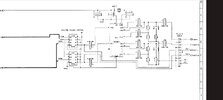Hi
I have this audio circuit where the right channel is really quiet. I can here it increasing volume if I adjust it by the digital potentialiometer. But overall it sounds about 15% of what it should be,
I've replaced the
Td42004 amp
X2 digital potentiometers
Most of the larger electrolytic caps.
I can't seem to cure this fault though. Please can anyone explain the amp bootstrap?
It's like the audio is there but it's not getting amplified correctly.
Thanks
I have this audio circuit where the right channel is really quiet. I can here it increasing volume if I adjust it by the digital potentialiometer. But overall it sounds about 15% of what it should be,
I've replaced the
Td42004 amp
X2 digital potentiometers
Most of the larger electrolytic caps.
I can't seem to cure this fault though. Please can anyone explain the amp bootstrap?
It's like the audio is there but it's not getting amplified correctly.
Thanks




